by
Prof. Dr. A. v. Brandt
Leitender Direktor Institut für Fangtechnik
Bundesforschungsanstalt für Fischerei
Hamburg, Federal Republic of Germany
Successful fishing methods are based on a good knowledge of the behaviour of the fish to be caught. It has been truly said: fishing methods and tactics are applied knowledge of fish behaviour. This is especially so for eel fishing and it is not astonishing therefore, that eel fishermen generally are specialists in this subject. It will be understandable, therefore, that a detailed report by Dr. Mohr about eel behaviour is a fitting introduction to this series of lectures.
Under discussion is the freshwater eel only; not the conger eel. In Northern Europe the eel lives and feeds in freshwater for about 10 years and, during this period, can be attracted and caught by means of baited fishing gear and/or such as will offer a place of refuge. Thereafter, the eels begin to migrate back to the sea and fishermen try to catch them on their journey by means of fishing gear which filters the eel from the water current.
Eels are caught in lakes and rivers and also in coastal waters, especially in the estuaries of rivers. Commercial fishermen engage in eel fishing as so do sport-fishermen, both with increasing interest. In this discussion, commercial fisheries only are dealt with and the emphasis is on traditional (local) fishing methods rather than with industrial ones. Eel fisheries are more a part of small, traditional fisheries; mechanisation is little employed even when heavy gear is operated.
Most methods used in eel fisheries are passive in nature; that means the eel has to come to the fixed or drifting gear, or it may be attracted by some stimulant or because a refuge is offered. Coastal fishermen, however, use active methods such as trawls to catch eels and the tendency nowadays is to use trawls in lakes and rivers as well.
Set out hereunder is a short synopsis of the different methods of eel fishing which I have set out in accordance with my own classification of fishing gear and methods. This classification is based on the principles of catching and the development of fishing methods. No distinction is made as between the importance of the different methods; neither is there any attempt to identify the efficiency of capture of each. In all, fifteen types of fishing gear are listed but not all are of interest as regards eel fishing.
As far as is known, there does not exist a fishery for freshwater eels without the use of fishing gear; neither by gathering by hand, nor by digging out, nor by collecting by means of divers. The method of collecting fish by emptying ponds or any other small areas of water, such as is popular in some tropical fisheries, can be ignored as far as eels are concerned. It has been the experience of pond fishermen that it is very difficult to get the eels in ponds which have been emptied of water.
Eel fishing with wounding gear is much more important, especially with spears (Fig. 1). The spear is one of the oldest types of fishing gear used in eel fishing. Different types of spears have been developed for this purpose in many parts of the world: in Europe as well as in the Far East and South East Asia, and other areas besides.
Eel spears can have one or more prongs which are barbed in this case. In some countries, like in Germany, the distance between the prongs is regulated by law.
The eels are caught by being impaled. It often happens that the operator misses and only succeeds in wounding the eel which escapes although badly injured. It also can happen that very small fish can be caught. For this reason the use of spears is forbidden in some countries. In Germany special permission is necessary to use such spears and this is restricted to older fishermen, who are no longer able to handle heavier fishing gear or to go out with a vessel for a considerable time.
The prongs of fishing spears can be replaced by spring clamps. Such types of spears are used by Danish fishermen. In Denmark also, the distance between the clamps is regulated by law. Clamps are considered to be the best kind of spears making it possible to catch and hold the eel without wounding it.
Sometimes eel spears can consist of a combination of clamps and prongs such as occur in Germany and in Canada. In these the prongs are unbarbed. The so-called Canadian “summerspear” has two flexible wooden clamps bolted to a long iron spike. The design of these combined spears was devised originally to protect the sharp points against damage by hard ground.
In dealing with spears mention must also be made of the modern Danish eel tongs. These tongs are operated by a rubber band or a spring. They snap together when a trigger is released.
Eel combs are well known in Europe as well as in Asia (Fig. 2). The comb is usually towed through the mud piercing any eels which happen to be in its path. The eel can escape although badly wounded and for this reason these combs are forbidden in some countries.
In Japan a special needle comb is used for eel fishing. The eels, when observed swimming under a light, are struck on their heads with this gear and thus caught by the fishermen.
All spears have long wooden handles, the length of which is limited by the buoyancy which increases with the length. A length of 7 m is considered to be the practicable limit. This, however, does not exclude the possibility of spears with longer handles - these may be up to 20 m. The wood of the handles, however, has to be flexible and it is necessary to weigh the spearhead to offset its buoyancy.
Spears are usually employed to catch eels lying in the mud during daytime. In winter longhandled spears are used also to catch eels under the ice. Except with electricity it is not possible otherwise in Northern Europe to catch eels in winter. Spears can also be used during nighttime for eelfishing usually with the aid of artificial light. Special arrangements can be made to increase the efficiency of this method by forcing the eels to pass through restricted water channels. In Madagascar such an arrangement is employed at the outlet of lakes when the outflow is through small stonehouses where the migrating eels are caught with spears, as they pass under the light.
The use of narcotics to capture fish, especially with ichthyotoxic plants is well known all over the world. But these plants as well as poisons of animal origin or even the new so-called “chemical fish collectors” are more successful for pelagic fish which rise to the surface of the water. Any other fish are difficult to collect. This may be the reason why narcotics are not used for the capture of eels.
Another stupefying method which has become very important in eelfishing during recent years is electrical fishing. In this case the affected fish is not lost but it can be caught without difficulty because of its anodic reaction to electric current. Electrical eelfishing has become so important that a special report has been prepared on this subject by Dr. Halsband (Appendix 7).
In linefishing, a natural or artificial bait is fixed to a line and is offered to the fish to be caught. The fish tries to swallow the bait and is lifted from the water before it can release it. In order to hinder the fish in its effort to reject the bait, fish hooks of different types are employed hidden in the bait.
A hookless linefishing method is known in many countries; in England this is known as “bobbing” or “blobbing”, etc. In this method lob worms are threaded lengthwise on a rough twine (sometimes made up of a combination of hemp and wool). This wormline is crowded together and weighted with small lead shots (Fig. 3). It is fished at the bottom where the eel comes across the bait and becomes entangled by its teeth when taking the bait. The eel can then be caught if lifted very quickly out of the water and over a box or an open umbrella held upside down to receive the fish. This method is known not only in Western Europe but also in Turkey. Some Australian tribes also practice it. Modern eelbobs are made of a little bag of nylon hoses filled with bait and a weight. Here also the eel is caught by becoming hooked by its teeth in the fabric when attempting to get at the bait as already described.
Lines with hooks are used in present-day eelfishing. These hooks can be curved in the usual form, but gorges are also known (Fig. 4). In France, gorges are used especially for eelfishing even today. In England, gorges in the form of needles are used for eelfishing in a method called “sniggling”.
Handlines are seldom used in commercial eel fisheries. They are therefore omitted from this account. In contrast to commercial fisheries handlines are an important fishing tackle used by sport-fishermen for eel fishing. Since Isaac Walton's “The Complete Angler” (first edition 1653) a lot of books have been published describing methods used by sport-fishermen for eelfishing.
The most important method of commercial eel fishing in freshwater or coastal waters is longlining with up to 3 000 hooks (Fig. 5a). Some people are of the opinion that this is the best method to catch eels which are still taking food. For this reason, this method is the subject of a special report by Dipl. Biol. Kaulin (Appendix 5).
There is, however, another line-fishing method practised by some commercial fishermen worthy of mention, that is eel fishing in lakes with driftlines. (Fig. 5b). Floats made of rush or other light-coloured materials are set in the evening in such a manner that they drift with the wind across the lake during the night. To each is attached one small single hook, baited and hanging 1 or 2 m deep according to the depth of the lake. “The driftline is searching for the eel itself!” say the fishermen. These driftlines are considered much more effective than longlines. On the other hand driftlines cannot be used on small lakes nor can they be used during periods of strong wind.
The term “trap” is used in a wide sense in connexion with eel fishing. It can be a filtering barrier placed in the current of a river of a portable wooden basket or a fyke net made of netting. In coastal waters it can be a very large, more or less, permanent pound net.
Two methods only need be mentioned here: the filtering barrier and the trap in the form of a hiding place or refuge. The other types of traps used are discussed in another report (Appendix 8).
Filtering barriers erected in rivers or in the outlets of lakes to catch migrating eels are known in many parts of the world. In the Federal Republic of Germany these devices are incorporated in mill dams. The water flow is directed through a tank, part of which is made of lattice work which allows the water to escape but retains the eels (Fig. 6). In this country the space between the laths is regulated by law. The minimum distance varies in the different parts of Germany from 15 to 30 mm. In such devices, it is important to provide shelter for the captured eels in order to prevent their being damaged by being pressed against the lattice work by the water current. There is a trend in this country to support the building of new filtering barriers such as those as they are considered to provide the most efficient method of capturing the total quantity of migrating eels. It has been also proposed that these barriers should be owned by fishermen's cooperatives.
A special filtering method is employed in the Far East. This is employed to catch young eels migrating upstream against the current. They are caught by leading them into special channels in which are placed bagnets from which they cannot escape.
In Japan, there is another filtering method which is called Yana. This is a slanting screen placed in the current of a river. While the water escapes through the slats of this screen the fish are retained by the screen and are washed up the slope of the screen by the strongly flowing current. The eels stranded in this way are collected from the screen. This must be done constantly during day and night in the main fishing season. In some cases, however, openings are cut in the screen and fitted with net bags into which the eels can pass but cannot escape.
Mention must also be made of the filtering barriers built by the Italians to catch eels passing from the sea into brackish lagoons, or vice versa. The fish are concentrated in these traplike barriers and removed by scoopnets.
Quite another trapping method for eels is based on offering shelter or refuge for the eels. In Madagascar, fishermen dig out small underwater holes into which the eels enter for shelter. The fisherman dives and takes out the eels with the help of spears.
Bundles of brushwood were used at one time to capture eels searching for shelter, but only small eels are caught by this method. This method is also employed to catch shrimps in many parts of the world. In Japan, units made up of three bamboo tubes fastened together are submerged in the water and the eels like to hide in these (Fig. 7). The smallest such trap for eels measures 2 cm across and 70 cm in length. This trap has no retarding devices, such as valves and great care must be taken when lifting to make sure that the eel does not slip out.
However, wooden baskets (Fig. 8), fyke nets (Fig. 9), made of netting or chicken wire and pound nets (Fig. 10) are more important for eel fishing. The baskets are used in rivers mostly in groups connected with a line. The fyke nets are specially used in lakes or along the seashore, sometimes incorporated in large fishing arrangements. Large pound nets for eels are especially known off the Baltic coast of Denmark and Germany. As all these traps are so important they will be dealt with at length in a special report (Appendix 8).
Aerial traps are special devices designed to capture fish and shrimps which jump out of the water. They are not applicable therefore, to eelfishing. Eels migrate sometimes over land from one water body to another as also do some other fish. The Burmese fishermen employ special pitfall traps for fish trying to make their way over land, but I do not believe that eels can be caught by this method.
In this group are scoop baskets and all net bags, the mouths of which are retained in the open position with the help of a frame and the body of the net extended by the water current. The small scoopnets can be neglected as also can the large scrapenets used by the Japanese to catch eels in rivers (Fig. 11).
The large stownets are of great importance in fishing for eels in rivers (Fig. 10). They are employed fixed on stakes driven into the bed of the river or swimming free but held in place by anchors. They can be mounted on large frames and suspended from booms mounted on boats anchored in the river stream. The most modern development is the otter board stownet.
When the Dutch fishermen introduced the so-called “Ankerkuile” in the river Rhine at the beginning of this century, the selfishing increased very much. Stownets are important today even in spite of pollution, canalization and increasing shipping traffic. A special report on stownets will be given by Dr. Klust (Appendix 6).
There are no dredges used for eelfishing. But coastal fishermen employ special bottom trawls for this purpose. These are small meshed trawls with a footrope 70 ft long (Baltic) or 135 ft long (North Sea). The eel trawls are towed with otterboards, or by two boats in pairfishing. In olden times eel-trawls were operated by sailing broadside single boats.
In recent years two-boat bottom trawls as used by the coastal fishermen have been introduced also in lake fisheries and in rivers and have been found to be very economical (Fig. 13). A special report will be submitted by Dr. Steinberg on this subject (Appendix 10).
Sometimes seine nets and trawls are included in the same group of fishing gear. But with trawls a theoretically unlimited area can be fished according to the length of the towing time. In contrast, the catching area for seining is limited by the length of the wings of the net and by the length of the towing ropes. When the seine net is shot the set cannot be shortened or extended as can be done with trawls. The fishing unit for trawls is the towing hour; for seine nets it is the set.
Seine nets are used in freshwater eel fisheries and to some extent for beach seining along the sea coast (Fig. 14). There are special seine nets of large size for eels. More popular in this country are very small ones which can be handled by one fishermen only.
Nowadays mechanised and/or electrified seine nets are of some interest in eel fishing and a special report on this subject will be submitted by Dipl. Biol. Kaulin (Appendix 9).
This concludes the most important fishing gear used for the capture of eels. The last 6 groups referred to in my classification of fishing gear are only mentioned to complete this account.
There is no fishery for eels which employs gear like purse seines or lampara nets which have been specially developed for pelagic fish.
It is only in tropical countries that one will encounter the typical drive-in fishery for which special gear has been developed. On the other hand a drive-in fishery for eels has developed in connexion with electrical fishing. The eels are driven into stationary fishing gear with the help of electricity. This will be dealt with in a report by Dr. Halsband (Appendix 7).
This fishing method can be omitted even though the Japanese use rectangular lift nets to catch eel fry.
There are no methods of eelfishing using (13) falling nets like case nets or coverpots. It will be also understandable that there are no (14) gill nets or (15) entangle nets used in eelfishing.
This summary demonstrates that there are many specialized methods employed in eel fishing. This specialization can be demonstrated by the fact that in Germany the particular names of the many fishing gears are derived from this specialization: eelspear, eelline, eeltrap, eeltrawl, eelpoundnet, etc.
Today all these gears are made from synthetic fibres. In general, the change from the natural fibres to synthetic ones has resulted in increased efficiency and very often also in a simplification in the construction of the gear. These improvements, however, have been confined in the main to traps and stownets and not much has been done for the improvement of other kinds of eelfishing gear. There is no doubt that efficiency could be increased if more research work could be done - especially work on the application of light and electricity to eelfishing methods.
It will be clear from this summary that many of the items are specially suited to particular kinds of fishing waters. The following list gives a rough summary where each can best be employed in the light of the experience on the subject gained in eel fisheries in the Federal Republic of Germany:
| Lakes | Rivers (b) | Estuaries (c) | North Sea | Baltic | |
| Spears | + | + | |||
| Electric fishing | + | + | + | ||
| Longlines | + | + | + | ||
| Barriers | +(a) | + | |||
| Baskets | + | + | |||
| Fyke nets | + | + | + | + | |
| Poundnets | + | ||||
| Stownets | + | + | + | ||
| Trawls | + | + | + | + | + |
| Seine nets | + | + | + |
(a) Barriers can be employed in the outlets of lakes only.
(b) In the case of rivers, apart from stownets, the other gear mentioned can be used at the side of river channels or in the backwaters only.
(c) The estuaries in question are those of the rivers Elbe, Weser and Ems.
Deelder presented v. Brandt with a Dutch eeltrap for the museum in the Institute. (This trap is described in Deelder's paper.) He stated that prohibition of trawling in the IJsselmeer has lead to the increased use of this new simple device.
McGrath described traps used in Ireland which were very similar to the “Yana” Japanese trap. McGrath also referred to Canadian traps of a similar design. He also mentioned that eels when trapped will use their tail as a wedge to force their way out of traps. He had once witnessed an eel using its tail as a lever to get over an obstruction. It had been observed in Ireland when treating small lakes with rotenone for the purpose of clearing coarse fish for the better production of game fish, that eels emerged from the lake on to the land to escape the effects of the chemical.
Vickers referred to the more efficient methods of eel catching and wondered if the eel stocks of Europe would ultimately survive all the new methods of exploitation. He would welcome discussion on this point.
v. Brandt explains that it is the aim of gear research to develop fishing gear with a highest efficiency but lowest amoung of money and manpower. Gear research has nothing to do with limitations which may be necessary for biological reasons. The quantity to be caught is a problem of catch regulation and not of gear research.
| Kaulin | - | a system is used to avoid plants and keep bait clear of mud. |
| McGrath | - | enquired whether stratification in the lake interfered with fishing. |
| Kaulin | - | no effect. |
| v. Brandt | - | mentioned use of unbarbed hooks in places such as Nemi Lake in Italy, such hooks required tight line at all times. |
| McGrath | - | asked for information of use in other countries: barbed hocks used in Holland, Ireland and Hungary. |
A Discussion on bait followed.
| Vickers | - | small fish preferred on Lough Neagh; stickleback for two weeks in July in shallows of Lough Neagh, catch broad-nosed eel. Normal bait-slices of Coregonus which catch sharp-nosed eel. |
| Deelder | - | Smelt during whole season; long crosslines are occasionally used on the lines, possibly due to habit of eels in swimming for some time before swallowing bait. In summer small perch and ruff used. |
| Vickers | - | Coregonus bait seems to be positively liked by eels; small pieces of perch and pike fail. |
| Deelder | - | considers smelt perfect bait but mentions that IJsselmeer smelt will not catch eels in other waters. |
| Mohr | - | Arenicola very effective in Germany. Coregonus should come from same lakes as eels to be effective. |
| Thuranszky | - | slices of bream effective in Hungary. |
Conflict of sport and eel fishing.
| McGrath | - | in Ireland longlines used over mud catch eels, over gravel catch trout. |
| Thuranszky | - | no report of conflict between interests. |
| v. Brandt | - | branchline should be long so that eel does not notice attachment of bait. |
| Moriarty | - | asked information on depth of fishing. |
| Koops | - | very variable, depending on season, lake, etc. |
| McGrath | - | asked for information on conservation. |
| v. Brandt | - | any size may be taken in enclosed lakes. |
| Koops | - | mentioned general 30 cm size limit. |
| Mohr | - | H2S concentration in deep water may poison eels caught on longlines. |
| Larsen | - | H2S gives trouble in Denmark at 12 m and deeper. |
| Thuranszky | - | 2 m is usual depth for fishing in Hungary. |
| Larsen | - | Eels are pelagic in larger lakes and dive for food, their visits to dangerous deep water are therefore normally brief. |
| Mohr | - | confirms pelagic habits, mentioned that eels feeding on Coregonus caught in nets 10 m above the lake bed. |
| Koops | - | salted herring is a good bait but suggested that as the food animals change frequently longlining success could be increased by noting stomach contents. Described method of attaching hook to bait in rivers. |
| McGrath | - | described use of pilchard oil on cotton wool in perforated plastic bag to attract eels to location where they can be removed by electro-fishing. |
| Vickers | - | refers to Koops; mentions that fish is rarely found in stomachs although Coregonus is an excellent bait; does not think that stomach contents would be useful guide. |
| Mohr | - | live Guppies were good food for aquarium eels, males were eaten largely. The females were better swimmers and usually escaped. |
| Moriarty | - | eels below 30 cm rarely eat fish; asked for information on size of fish-eating eels. |
| Koops | - | considers this depends on habitat. |
| Moriarty | - | asked for information on sise limit. |
| Larsen | - | in Denmark overall 25 cm; in Limfjord 28 cm and in West Jutland 29 cm. |
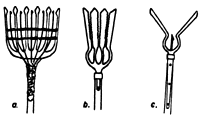 | 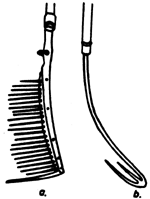 | ||||
| Fig. 1 | a. b. c. | Eelspear of northern Europe Danish eel clamp German combined eelspear | Fig. 2 | a. b. | Eelcomb from the Baltic area Japanese eelcomb |
 | 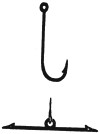 | 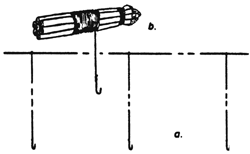 | |||
| Fig. 3 | Hookless handlines: “eel bob” | Fig. 4 | Hook and gorge | Fig. 5 | a. longline b. driftline |
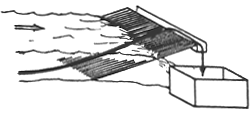 |  | ||
| Fig. 6 | Principle of a filtering barrier White arrow: water current Black arrow: way of the migrating eel over the grating in a collecting box | Fig. 7 | Shelter of bamboo reeds |
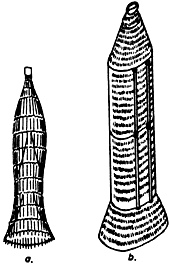 |  | ||
| Fig. 8 | Baskets made of wood (a.) and plastic (b.) | Fig. 9 | Fyke net with wings |

Fig. 10 Poundnet for eels off the Baltic coast
 | 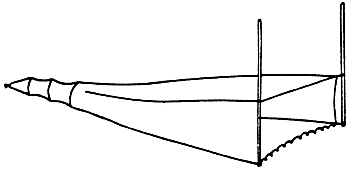 | ||
| Fig. 11 | Japanese scrape net | Fig. 12 | Stow net fixed on stakes |

Fig. 13 Two-boat bottom trawl for lakefishery

Fig. 14 Seine net with bag